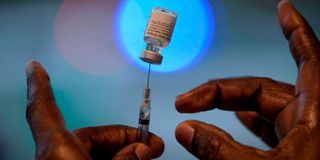Beat infectious diseases by first ending stigma

A healthcare worker prepares a dose of the BioNTech Covid-19 vaccine at a vaccination hub location in League City, Texas.
Health has been a key area of focus for the government in recent years, with large-scale reforms such as Universal Health Coverage (UHC).
Preventive health, in particular, has received renewed attention following the Covid-19 pandemic. The World Health Organization defines a pandemic as a worldwide spread of a new disease. Their similarities notwithstanding, each infectious disease outbreak comes with different forms of stigma.
A systematic review and meta-analysis on the prevalence of stigma around infectious diseases – including Covid-19 last year – by Huang XL, Zhang YX and Huang YT found that infectious disease-related stigma is a significant public health concern during epidemics. This calls for effective and comprehensive interventions to eliminate or reduce disease-related stigma.
From the 19th century’s smallpox to the 21st century’s Covid-19, epidemics have always been associated with stigma and severe social consequences. The mention of leprosy, SARS, Zika, HIV/Aids, tuberculosis (TB), and more recently Ebola and Covid-19, invokes notions of isolation, fear and hostility.
Healthy behaviours
Stigma can drive people to hide an illness, prevent them from seeking health care immediately or discourage them from adopting healthy behaviours.
Fahimeh Saeed rightly observes that stigma impacts health-related outcomes, not only as a barrier to receiving a timely diagnosis and appropriate treatment but also as an important variable that increases mental health issues such as anxiety and depression.
According to Leah Fischer, Mansergh, Gordon, Lynch, Jonathan, Santibanez and Scott, the stigma associated with an infectious disease can be a barrier to adopting healthy behaviours, leading to more severe health problems, disease transmission, and difficulty controlling infectious disease outbreaks.
Research from HIV, Ebola, Hansen’s Disease and other infectious disease epidemics also show that stigma undermines efforts at testing and treating disease. It manifests in such forms as isolation and verbal and physical aggression. Common drivers of stigma include fear of infection, misinformation, economic consequences of the disease, lack of awareness and socially constructed stereotypes.
Responding to stigma in the health system requires an equally comprehensive approach, through system-wide interventions in education, training practice and policy. Lessons from previous pandemics show that multidimensional approaches for healthcare, considering all bio-psycho-socio aspects and employing strategies to enhance communities’ empathy and resilience, pave the way toward the goal of reducing stigma.
The red ribbon symbol of HIV/Aids awareness, care, empathy and support, for instance, is noticeable around the world. A second recommendation gleaned from the polio experience is to facilitate inclusive community engagement, leverage existing community networks and co-creating with community leaders.
Ms Sirima is public communications officer at the Pharmacy and Poisons Board. [email protected].





